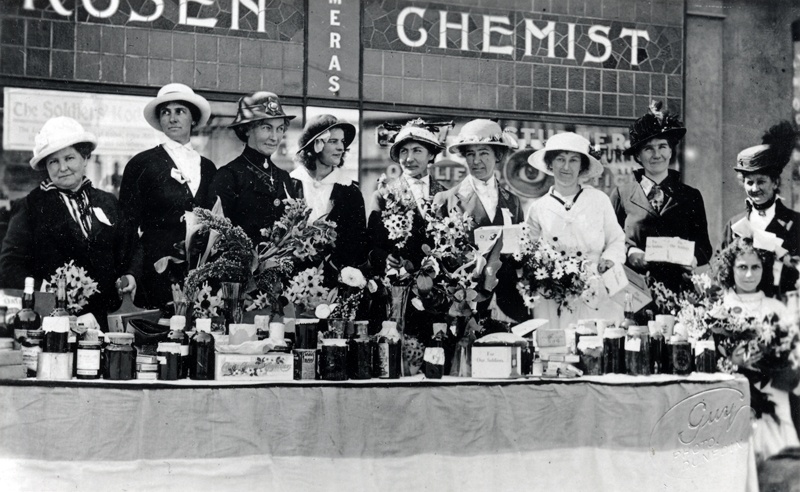
Members of the Otago and Southland Women’s Patriotic Association are photographed at one of their many fundraising events for Belgium.
An appeal to the women of New Zealand
At this moment of our Empire’s needs I appeal to the women of New Zealand to assist me in trying to provide any necessaries which may be required for … the citizen army …. My suggestion would be to start a fund in every centre under a small committee of ladies.
Annette, Lady Liverpool (whose husband was New Zealand’s governor), made this plea the day after the outbreak of war in August 1914. She urged women to provide useful items for soldiers: shirts, underclothing, socks and darning kits (known as ‘housewives’).
Women across the country immediately took up her call. By the next day, a ‘little band’ of Wellington women had made 250 housewives, sewing into them ‘all sorts of hopes and fears’, according to the Evening Post. Within days, over 800 women attended a public meeting in Dunedin – the largest in the city to that date – to form the Otago and Southland Women’s Patriotic Association.
More than 900 women’s patriotic organisations operated during the war. Women made a huge contribution to New Zealand’s war effort through these groups, and they took a lead role in supplying material to people in war-torn Belgium and France. By the end of the war, women’s groups had raised nearly £5 million.
Patriotic work was important for the women as well. ‘When this awful war broke out we women all felt that we must do something,’ said Lavinia Kelsey of the Otago and Southland Women’s Patriotic Association. Women not in paid employment kept themselves busy by making clothes for Belgian children, knitting socks for New Zealand soldiers or raising money through garden fêtes and market stalls. Work like this also gave women who were lonely and anxious about what was happening overseas a sense of being close to husbands, fiancés, brothers and sons on the other side of the world.
Home comforts
Many women’s organisations were small working bees – groups whose members gathered to knit or stitch items of clothing for soldiers. Women took it upon themselves to provide the comforts that soldiers needed in their kitbags: two pairs each of socks and underpants; two each of woollen shirts and undershirts, towels and cholera belts; and one handkerchief, chest protector, pair of braces, holdall, balaclava cap, service bag for rations and ‘housewife’. Other groups supplied hospitals in New Zealand with clothing for returned soldiers.
Some women focused their efforts on helping particular groups of soldiers or others affected by the war. Lady Liverpool’s and Mrs Pomare’s Maori Soldiers' Fund provided items to Maori men serving in Gallipoli, France and Belgium. Taranaki women formed the Eltham Belgian Sewing Guild to provide clothing to women, children and the homeless in Belgium. The Dominion Stocking League sent old socks and stockings to a local hospital for sterilisation, then converted them into clothes for Belgian and British children. These women placed a penny in the pocket of every garment they made.
In 1916 women’s patriotic committees formed the Dominion Parcels Scheme. Until the end of the war, the scheme sent parcels to soldiers overseas at the rate of 24,000 per month. Some women’s groups met daily to manage the demands of filling parcels with tobacco, tinned food and hand-made woollens such as socks.


Community contributions